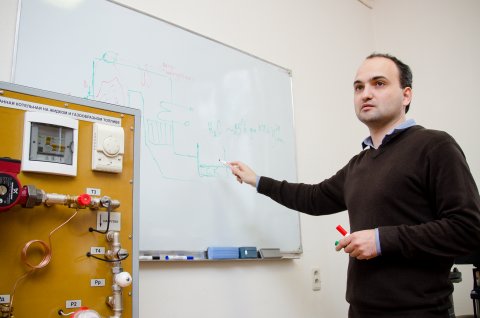Associate Professor at the Department of Industrial Thermal Power Engineering of South Ural State University Konstantin Osintsev has developed an energy technology complex based on solar collectors which would allow to implement elements of renewable power generation at thermal power plants.
The renewable power generation innovations are widely spread in Europe and America. However, most of them are mainly implemented at solar and hybrid power plants. The SUSU scientist became concerned with the issue of using elements of renewable power generation, particularly with using of solar collectors as applied to thermal power plants operated on non-renewable fuel resources.
The idea of developing an energy technology complex based on solar collectors shaped itself after the scientist studied the experiment on implementing contact heat exchangers with active headers performed at Chelyabinsk Iron & Steel Works (Mechel) in the 1980’s. However, back then the tests were declared a failure due to the innovation’s inefficiency.
Similar solutions had been used abroad before elements of non-traditional and renewable power generation started being actively implemented in the industrial sector. The scientist thought of the use of solar collectors as the most promising ones. According to a SUSU’s patented technology, stack gases from an air heater are fed either to a recuperative, or a contact heat exchanger connected to a solar collector’s heating tank. The combination of the design’s specifics and of the way the two mediums are brought in contact with each other provides for the increase in the efficiency of a boiler unit.
The researcher had to solve two main tasks: where and how to install the collectors. He calculated that a solar collector should be installed outside a boiler house for more efficient use of the low-intensity solar radiation.
The energy technology complex designed by Konstantin Osintsev under Project 5-100 is a boiler unit or a power block intended for generation of power in the form of steam.
“Generation of thermal power using organic fuel means inevitable losses which we can’t eliminate. Thus, the only way is to try and improve the processes of combustion and disposal of stack gases. After the fuel combustion process has completed, stack gases are generated, including water vapours. These vapours when condensed may give us an additional increase in the efficiency of the whole installation,” explains Konstantin Vladimirovich.
After that, water heated in a heat recovery unit should be used in the thermal envelope of a power plant. Depending on the capacity of the power block’s boiler unit, the efficiency may be significantly increased, what is undoubtedly an economical advantage.
If certain modifications are applied to a heat recovery unit, it may be turned into a contact heat exchanger with an active header, which would allow for direct condensation of water vapours from combustion products. During condensation, part of aggressive gases, such as nitrogen or sulphur oxides, also becomes condensed, and the already cooled gas is emitted into the atmosphere, what is more ecologically friendly.
There exist analogous innovations, but those suggest installing solar collectors on separate buildings and not using them in the big-scale power generation ‑ only in its renewable part. Konstantin Osintsev was the first one to try and combine renewable and non-renewable power generation. The ideas on combining renewable and non-renewable power generation were partly described in a Scopus article published in May 2017.
In the future this innovation may be implemented not only for thermal energy generation, but also in the housing and utilities sector, at small-capacity boiler houses.
The scientist is planning to create laboratory benches and a test prototype, and then to try commercialize the latter.
“If as a result of creating the laboratory benches we understand that we need patents for additional parts of the heat recovery unit, we will make them our intellectual property, and after that we will be addressing organizations and offering them to implement our innovation. Our heat recovery unit is universal and may be used almost in any region,” says Mr. Osintsev.
Using complexes based on solar collectors in the future may help solve part of the problems related to consumption of energy resources, and it is quite a topical issue for the Chelyabinsk Region. Implementing such installations will partly help in saving, as well as in reducing the dependency on coal.




